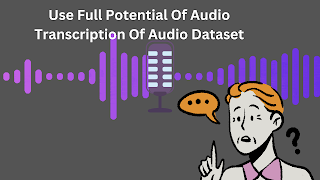Use Full Potential Of AI Transcription Of Audio Datasets In Machine Learning Process Audio Datasets?
Use the full potential of Audio Transcription of Audio Datasets in the machine learning process Audio Datasets?
Make full use of the AI transcription of Audio Datasets to aid in the machine-learning process Audio Datasets.
Audio transcription
GTS use large-scale, human-made voice and audio data sets to support machine learning in high-performance speech recognition systems that convert natural languages into text. Only certified individuals can transcribe audio. They must follow the instructions and be verified before they can be approved.
These training data will allow your speech recognition system to continue learning and improving.
In a short period, a large number of transcriptions of audio were made.
There are many languages to choose from.
proper punctuation
An audio-specific commentary is also available.
different data formats
Audio transcription quality verification
Classification of Audio Datasets & Voice Datasets
To train an AI/ML model, audio data is necessary. It must be collected and harvested. These facts include the following:
- Data on speech (Spoken words in spoken languages of people from different accents, dialects, and languages)
- Different sounds (Animal sounds, sounds of objects, etc.
- Music data (music and song recordings).
- You can also capture other digitally recorded sounds, such as coughs and sneezes.
- Background noises or speech in the distance
- These audio data can be used for training these technologies.
- Smartphone's, intelligent appliances, virtual assistants (Google Home, Siri, Alexa, and Alexa), etc.
- Smart cars with systems
- Security voice recognition systems
Vocal robots
Other voice-activated solutions
What are your challenges when collecting audio data?
Language and accent difficulties
There is a growing demand for innovative home technology around the globe. You will need audio data in various languages and accents to make these devices widely accessible. It is a challenging task.
Time-consuming
Recording audio data is more time-consuming than recording image data. Audio data can be recorded at any time, unlike image data, which can only be captured at a single point in the past.
Audio data can be collected in many languages, accents, voices, and voice types, including male or female, high/low pitch, and female. It can take longer to collect if audio data contains jargon, voice variations, or resolutions.
High-end
It all depends on how complex and large your project is. It can be costly and time-consuming to collect audio data internally. Audio data collection can add to your project budget if you need more AI Training Datasets. The size of your dataset will affect the cost of collection.
The cost of audio data collection can be affected by several factors.
Collecting of participants and collectors
Equipment to record and store voice
Legal and ethical issues
A second problem is people's reluctance to share audio data, particularly speech data. It is biometric data. People are reluctant to give their voice information for security or privacy reasons.
What are the best ways to collect audio data?
These are the best ways to get past any difficulties.
- Crowd sourcing and outsourcing are both options.
- Depending on the project's size, audio data collection can be either outsourced or crowd sourced. Outsourcing may be the best option if the data is small and manageable. Crowd sourcing can be used to source large, diverse datasets.
- These methods allow the business's legal and ethical responsibility to be transferred to an external service provider. Automatization
- Because data is collected in large quantities without oversight, it can be challenging to maintain data quality. Automation is another way to collect data. A bot that collects audio data online can be programmed. This can be done within the company without needing too many people.
- Considerations in law and ethics
It is crucial to think about legal and ethical issues before you collect any data. This will help avoid expensive lawsuits. Data collectors must ensure transparency, as audio data can also be biometric.
Audio Datasets
Your life is constantly influenced by audio. Your brain processes audio data continuously and makes sense of it. This gives you information about your environment. This is an example of how you interact with others every day. When the other person picks up the conversation, it continues. Even though the environment seems quiet, you may hear rain or rustling leaves. This is the amount of audio interaction that you have.
Can you capture the audio circulating around you and make your own use of it? Yes, you can! These sounds can be heard and put into a format computer can understand.
- Wav (Waveform Audio File),
- mp3 (MPEG-1 Audio Layer 3),
- WMA (Windows Media Audio).
- Audio processing apps
- As we have discussed, audio data analysis is a valuable tool. What other uses could audio processing serve? These are just a few.
- To create audio feature-based music indexes,
- Radio stations: Music selection
- To search for similarities between audio files, use GTS.
- Speech Synthesis and Processing: The creation of synthetic voices for conversational agents
- Datasets for environmental sound
This page list Audio Dataset that can be used for environmental audio research. This list includes both proprietary and paid datasets. The datasets and a list of online sound services can be found at the bottom. These services can fulfil specific research requirements and create new datasets.
You can create two tables from the data:
- The Sound Events Table includes datasets that can help you research automatic sound event detection and automatic sound tagging.
- The Acoustic Scenes Table includes datasets that recognize context audio or classify acoustic scenes.

Comments
Post a Comment